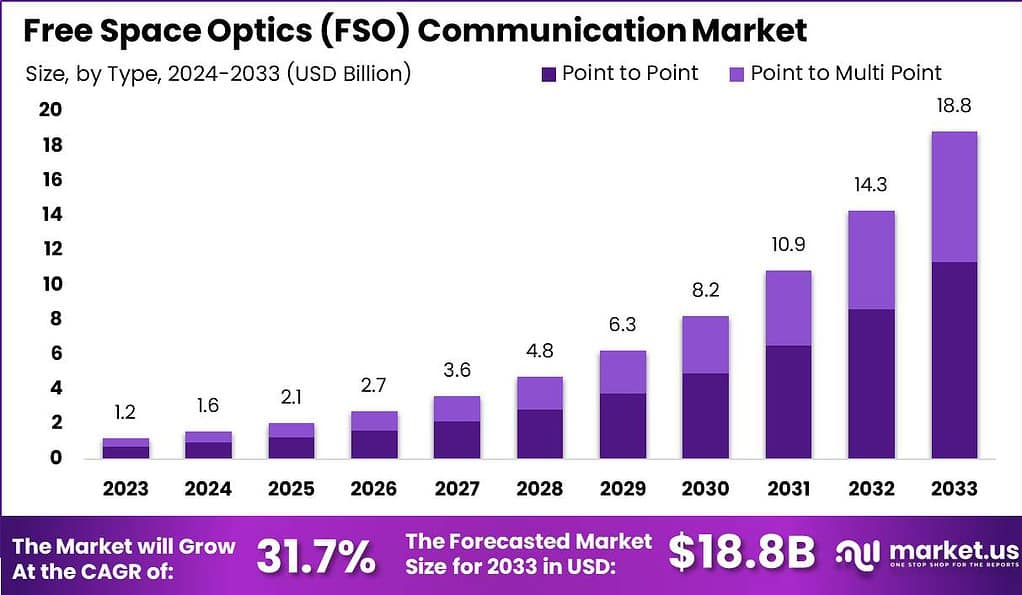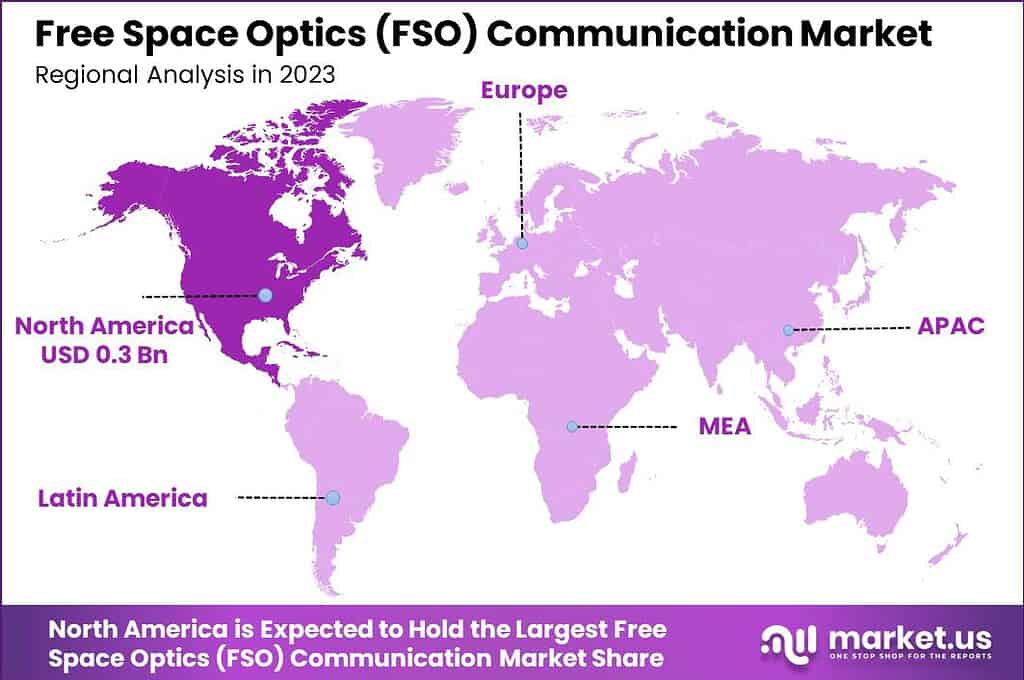Table of Contents
Report Overview
According to Market.us, the Global Free Space Optics Communication Market is poised for significant growth, with expectations to reach a value of USD 18.8 Billion by 2033, up from USD 1.2 Billion in 2023. This growth represents a robust compound annual growth rate (CAGR) of 31.7% during the forecast period from 2024 to 2033. The market’s expansion can be attributed to increasing demand for high-speed, reliable communication solutions, especially in urban areas with limited access to traditional infrastructure.
The free space optics communication market is advancing in response to increasing demand for high‑bandwidth and secure communication alternatives. Terrestrial deployments are strengthened by needs in remote or rural areas where traditional cabling is impractical. Applications in satellite and aerospace domains further expand potential. Market expansion is underpinned by improvements in optical component design, miniaturization, and growing interest in optical backhaul for next‑generation wireless connectivity (e.g. 6G).
Several forces are propelling growth. High‑speed data needs continue to escalate across enterprise, government, and military sectors, making optical solutions appealing. Secure communication requirements favor free space optics because of immunity to electromagnetic interference and narrow beam properties. The relative cost advantage of deploying optical links over laying fiber in difficult terrain amplifies adoption.

Investment opportunities in the FSO market are being shaped by the push toward smart urban infrastructure and expanding digital inclusion in underserved regions. Governments and private investors alike see FSO as a vital technology for bridging the last-mile connectivity gap, supporting public safety communications, and powering the foundation of smart cities. Strategic mergers and partnerships, along with research in radiation-resistant components for space applications, signal a growing belief in the long-term potential and relevance of FSO. The market’s structure encourages both organic growth and strategic collaboration to meet rising bandwidth demands and speed up digital transformation.
Key Insights
- The global FSO market is projected to grow from USD 1.2 billion in 2023 to USD 18.8 billion by 2033, achieving a remarkable CAGR of 31.7%, driven by demand for high-speed, license-free, and secure communication solutions.
- North America led the global market with a 32.7% share, generating around USD 0.3 billion in revenue in 2023, supported by strong investments in defense, aerospace, and next-gen connectivity infrastructure.
- The Point-to-Point application dominated with over 60.1% market share, owing to its simplicity, cost-efficiency, and effectiveness in high-speed, line-of-sight communication setups across buildings and towers.
- Transmitters held the largest component share at 30.1%, reflecting their critical role in enabling strong, stable signal emission over long distances in clear atmospheric conditions.
- The Space-to-Ground segment gained significant traction, driven by the increasing use of FSO in satellite-to-Earth links, ensuring rapid data transfer without spectrum congestion.
- Tactical Military Applications showed strong market presence, as armed forces adopt FSO for secure, jamming-resistant communication in remote and mobile operations.
- The Aerospace and Defense industry emerged as a major vertical, utilizing FSO for low-latency, high-bandwidth transmission in both terrestrial and space-based missions, enhancing data security and operational speed.
Role of AI
| Role/Function | Description |
|---|---|
| AI-Driven Beam Alignment | Automated tracking and re-alignment of laser beams for stability in fluctuating environments |
| Predictive Analytics | AI predicts signal disruptions, reroutes data, and improves uptime |
| Automated Network Management | Machine learning enables dynamic configuration, self-healing, and resource optimization |
| Signal Processing | AI reduces noise, interference, and enhances data throughput in real time |
| Integration in Satellite Ops | AI manages large FSO constellations for inter-satellite, satellite-to-ground, and mesh networks |
| Security Enhancement | AI/ML supports encryption, anomaly detection, and secure handoffs |
Top 5 Growth Factors
| Growth Factor | Description |
|---|---|
| Surge in Satellite/LEO Deployments | Need for fast, license-free, interference-resistant comms for satellites, CubeSats, deep space, etc. |
| 5G/6G Network Expansion | FSO used for high-bandwidth, last-mile, and wireless fronthaul/backhaul in urban/remote areas |
| Rise in Digital Connectivity Needs | Demand for cost-effective solutions in areas where laying fiber is difficult or cost-prohibitive |
| Adoption in Defense & Critical Infra | Secure, EM-resistant comms needed for military, border, disaster response, and critical infrastructure |
| Technological Advances & Cost Decline | AI-driven targeting, hybrid FSO/RF, quantum encryption, new materials—expanding FSO’s range & reliability |
Regional Analysis
In 2023, North America led the market, securing a dominant position with more than 32.7% of the market share, generating USD 0.3 Billion in revenue. The region’s leadership is driven by the growing adoption of free-space optics for secure, high-speed data transmission, supported by advancements in wireless communication technologies.

Driver Analysis
A key factor driving the adoption of FSO communication is the urgent need for high-speed, secure data transfer in settings where laying fiber is difficult or impossible. As digital infrastructure expands in urban, rural, and even space-based applications, FSO offers a solution that bypasses the delays and expenses of physical cables.
This technology is especially valuable for extending fast internet access to remote areas and supporting the explosion of data-heavy services, cloud computing, and next generation mobile networks. Its capability to deliver rapid, interference-free connections makes FSO an attractive option for industries requiring high security and minimal latency.
Restraint Analysis
Despite its promise, FSO communication faces genuine barriers stemming mainly from its sensitivity to environmental conditions. Factors like fog, heavy rain, snow, or even dust can significantly weaken or disrupt the light signals used in FSO links, leading to reduced data quality or total outages.
In places frequently affected by such weather, users may find FSO unreliable compared to more established alternatives like fiber optics or radio frequency communications. These vulnerabilities can limit the widespread adoption of FSO, particularly in regions with harsh or unpredictable climates.
Opportunity Analysis
A major opportunity lies in the deployment of FSO for bridging the “last mile” and “first mile” gaps in network infrastructure. Many businesses and communities are close to high-speed fiber networks but have no direct connection; FSO can wirelessly bridge this short final distance quickly and affordably.
The technology’s rapid installation and low regulatory burden also make it ideal during emergencies, for connecting temporary locations, or even for space communications between satellites and ground stations. As demand for more flexible and immediate connectivity grows, FSO stands poised to fill many of these critical gaps.
Challenge Analysis
One of the biggest hurdles for FSO is ensuring precise system alignment over time, especially as buildings or satellites move, or when mechanical vibrations occur. Maintaining a clear, direct path between the transmitter and receiver is paramount but can be tricky, as even slight shifts can break the connection.
The challenge intensifies with longer links or mobile nodes, requiring advanced tracking, correction, and stabilization mechanisms. For FSO to fulfill its potential, solutions that make alignment more robust and less labor-intensive are needed, without making the systems unaffordable or cumbersome to use.
Report Scope
| Report Features | Description |
|---|---|
| Market Value (2023) | USD 1.2 Bn |
| Forecast Revenue (2033) | USD 18.8 Bn |
| CAGR (2024-2033) | 31.7% |
| Base Year for Estimation | 2023 |
| Historic Period | 2019-2022 |
| Forecast Period | 2024-2033 |
| Report Coverage | Revenue Forecast, Market Dynamics, COVID-19 Impact, Competitive Landscape, Recent Developments |
Discuss your needs with our analyst
Please share your requirements with more details so our analyst can check if they can solve your problem(s)



